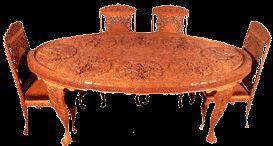
Wood Carving
Carved walnut wood-work is among the most important crafts of Kashmir. Kashmir is now one of the few places in the world where walnut is still available at an altitude of 5500-7500 feet above see level. The wood is hard and durable, its close grain and even texture facilitating fine and detailed work. It also presents visually interesting effects with mere plain polished surfaces in fact in contemporary products, plain surfaces and small carvings are preferred, especially on trays, tables, bowls and similar items. The Kashmir craftsman, however, rejoices in carving intricate and varied designs. A variety of carved products bear recurrent motifs of the rose, lotus, iris, bunches of grapes, pears and chinar leaves. Dragon motifs and patterns taken from kani and embroidered shawls all find their place in wooden objects with deep relief carving. A variety of articles, both decorative and utilitarian, ranging from small items like bowls, trays, cigarette boxes, wall plaques and table lamps to screens, bedsteads and larger items of furniture are carved in walnut wood. Four main types of carving are usually practised in Kashmir-raised, engraved, undercut and plain. The carving of furniture and smaller items is an elaborate process and involves high degree of skill and craftsmanship. The carving is done with the help of small indigenous tools. The art of wood carving is centred in the city of Srinagar.
...more
walnut wood carving
Carved walnut wood-work is among the most important crafts of Kashmir. Kashmir is now one of the few places in the world where walnut is still available at an altitude of 5500-7500 feet above see level. The wood is hard and durable, its close grain and even texture facilitating fine and detailed work. It also presents visually interesting effects with mere plain polished surfaces in fact in contemporary products, plain surfaces and small carvings are preferred, especially on trays, tables, bowls and similar items. The Kashmir craftsman, however, rejoices in carving intricate and varied designs. A variety of carved products bear recurrent motifs of the rose, lotus, iris, bunches of grapes, pears and chinar leaves. Dragon motifs and patterns taken from kani and embroidered shawls all find their place in wooden objects with deep relief carving. A variety of articles, both decorative and utilitarian, ranging from small items like bowls, trays, cigarette boxes, wall plaques and table lamps to screens, bedsteads and larger items of furniture are carved in walnut wood. Four main types of carving are usually practised in Kashmir-raised, engraved, undercut and plain. The carving of furniture and smaller items is an elaborate process and involves high degree of skill and craftsmanship. The carving is done with the help of small indigenous tools. The art of wood carving is centred in the city of Srinagar.
...more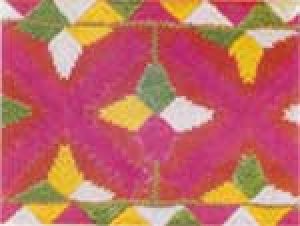
Phool Kari
Phool Kari - A traditional craft, recently revived, is Phoolkari, Bagh or Shaloo embroidered in the phoolkari style was an essential part of the bride's trousers till only a few decades back. A craft with its origin in Punjab Phoolkari, as the very name suggests is a style of embroidery of floral designs. The present day designs, however, are by no means limited to flowers alone and include a variety of other patterns. A variety of Phoolkari items like handkerchiefs, table covers, sofa and cushion covers, bed-spreads and wall hangings are now being produced on large scale that testifies to the increasing popularity of the craft among the local population.
...more
papier machie
Papier Machie is one of the most popular of crafts practised in Kashmir. The tradition of the Kashmir Papier Machie has its origin rooted in the 15th century when king Zain-ul-Abidin invited accomplished artists and craftsmen from Central Asia. A French term so commonly adopted in East and West and meaning "mashed paper" papier machine is in fact a unique combination of line and colour on moulded forms of a variety of objects. It involves ornamentation in colour over smoothened surfaces built up of paper pulp or layers of paper. Paper pulp is not always found effective and is some times replaced by other substitutes. The colours painted on object are made from pigments diluted in water to which some glue is added to fix the ground on which it is used. The three categories of colours are -- mineral (both actual and artificial) organic (both plants insects etc.) Vegetables. The final objects papier machie is given one or two coats of varnish which besides giving it shine serves as a protective agent. Important designs and motifs in papier machie designs are: Gulander Gul (flower in flower) Hazara (the thousand flowers) Gul Vilayat (the dear flower) Miniature Mugal paints Mythological figures Animals Hunting scenes Battle Scenes The product range covers ring boxes, pill boxes, boxes of assorted shapes and sizes, flower vases, wall plaques, bowls, ashtrays, screens etc.
...more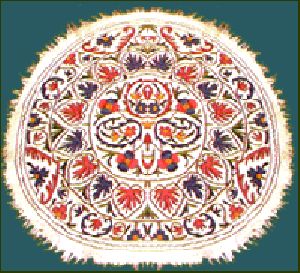
Namdha
Namdha - A hand made felt rug that makes excellent floor covering, made of unspun wool or wool and cotton pressed and felted in specific proportions, the rug originally came from Yarkand, Sinkiang and stayed to become an indigenous craft. The felt is embroidered with a hook in bold designs and assortment of colours. The sizes range from 2'x3', 3'x4', 4'x6' to 6'x9' feet and 3',4',5' 6' dia in round shape. The quality depends upon percentage of wool in the felt, popularly made quality is 32% wool, 50% wool and 100% wool.
...more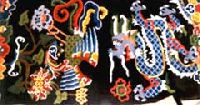
ladakh handicrafts
The carpet of Ladakh is indigenous to that part and has not been introduced from outside. The community of Buddhists inhabiting Ladakh mainly, prepares carpets for their personal use. People of the area have been weaving the carpets from very early times. Some opine for the carpets of being oldest. The carpet being the main form of furnishing, is used for sitting during the day and sleeping at night, seat their guests on it, and spread it for ceremonies and feasts. Women dominance is widely felt in weaving of the carpets. A vertical wooden loom, light in weight is the sole basis on which it is made. It requires simple wedges to tighten and tied the wrap thread which are looped to the beams and tied together. The usual size of the carpet is 3x6 ft known as Khalidan. These carpets are woven by the method of looping knots, known as "Khabdan" in local parlance. The designs woven into the carpet are generally derived from the religious myths. The motifs are inspired by the Mahayana Budhist symbolism. Dragon motif is quite common. A few more designs like Guanakchagri (Chinese, wall), Khorlo (three wheels), Tashi stak gyat (eight lucky signs), Mentok (flower) and Cha (birds) are also used. The eight lucky signs of symbols are those of lotus, wheel of religion, conch-shell, banner of victory, holy-vase endless knot, pair of golden fish and umbrella in Buddism.
...more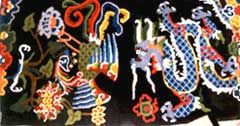
Ladakh Carpet
The carpet of Ladakh is indigenous to that part and has not been introduced from outside. The community of Buddhists inhabiting Ladakh mainly, prepares carpets for their personal use. People of the area have been weaving the carpets from very early times. Some opine for the carpets of being oldest. The carpet being the main form of furnishing, is used for sitting during the day and sleeping at night, seat their guests on it, and spread it for ceremonies and feasts. Women dominance is widely felt in weaving of the carpets. A vertical wooden loom, light in weight is the sole basis on which it is made. It requires simple wedges to tighten and tied the wrap thread which are looped to the beams and tied together. The usual size of the carpet is 3x6 ft known as Khalidan. These carpets are woven by the method of looping knots, known as "Khabdan" in local parlance. The designs woven into the carpet are generally derived from the religious myths. The motifs are inspired by the Mahayana Budhist symbolism. Dragon motif is quite common. A few more designs like Guanakchagri (Chinese, wall), Khorlo (three wheels), Tashi stak gyat (eight lucky signs), Mentok (flower) and Cha (birds) are also used. The eight lucky signs of symbols are those of lotus, wheel of religion, conch-shell, banner of victory, holy-vase endless knot, pair of golden fish and umbrella in Buddism. There is one more type of the carpet woven in Ladakh. This is a peculiar type of the carpet, the wrap and weft of the rug used are both of woollen yarn. This is called TSUKDAN in local dialect.
...more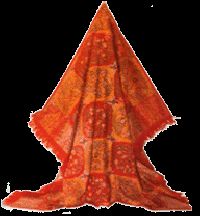
Kashmiri Shawls
The basic fabric is of the three types - Shah Tush, Pashmina and Raffal. Shah Tush (King of wool) passes through a ring and is also known as Ring shawl. It comes from a rare Tibetan antelope living at a height of over 14000 ft in the wilds of the Himalayas. Pashmina is known world over as cashmere wool, it comes from a special goat (Capra hircus) living at an altitude of 12000 to 14000 ft reared by shephered nomads around famous pongkong lake in close vicinity of western Tibet. Raffal is spun out of marino wool tops and is a popular type of shawl.The shawls are embroidered in floral motifs, various designs available range from Neemdoor, Doordaar, Paladaar, Baildaar, Jaalis and Jammas, with the help of needle. Where as kani shawls are woven on looms with the help of kanis. Kanis are small eyeless bobbins used instead of the shuttle.
...more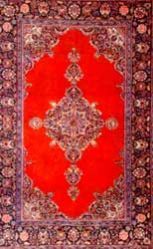
Kashmiri Carpets
The origin of hand knotted carpets locally known as "Kal baffi" dates back to 15th century after which it progressively attained the high degree of perfection. It is said that Sultan Zain-ul-Abidin brought carpet weavers from Persia and central Asia in to Kashmir to train the local inhabitants.There are different types of knots and in Kashmir the Farsi baff and the Persian system known as Sehna, or Sinneh, knot is originally used. Very simple tools are used to thread these knots, a wood or Metal comb to push knots and weft tightly together and pair of short scissors to cut the pile of the carpet to an even form once it is finished.
...more
kashmir silk rug
The origin of hand knotted carpets locally known as "Kal baffi" dates back to 15th century after which it progressively attained the high degree of perfection. It is said that Sultan Zain-ul-Abidin brought carpet weavers from Persia and central Asia in to Kashmir to train the local inhabitants. Carpets from 200 knots to 900 knotssq. inch both in wool & silk yarn have attained such excellence that they rank amongst the finest in the world. The loom used in Kashmir carpet weaving is composed of two horizontal wooden beams between which the wrap threads are stretched, one beam in front of the weaver and the second behind the first. The difference between a carpet and other hand woven rugs lies in the fact that short lengths of the thread or yarn are tied to wrap chains to form the pile of the carpet. These are commonly called knots though it is a loop rather than an actual knot. There are different types of knots and in Kashmir the Farsi baff and the Persian system known as Sehna, or Sinneh, knot is originally used. Very simple tools are used to thread these knots, a wood or Metal comb to push knots and weft tightly together and pair of short scissors to cut the pile of the carpet to an even form once it is finished.
...more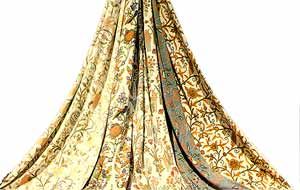
crewel
Crewel - A special kind of embroidery done with a hook known as crewel is commonly used for drapery and upholstery. Rows of chain stitch done with hook from solid patterns usually rotating from centre & creating an embossed effect to add richness to the textile. Crewel embroidery is done on thick material popularly used for furnishing and usually carries floral and creeper designs. The designs are available in assortment of colours ranging from a single colour to multi colour embroidery. The width of the material is 54 inches and is available in running meterage. The price is related with the amount of embroidery done on the material. This craft is also available on bed spreads in various sizes ranging from single to king size.
...more
Chain Stitched Rugs
Chain Stitch - Natively known as "Jalakdozi", chain stitch rugs are the speciality of Kashmir. These rugs are made on "hessain cloth" or hand made cotton cloth, in continued stitch with superior woolen or silken yarn, with the help of a hook type tool natively called "Aurah". The designs range from floral patterns to animal and human forms traced by a designer, while the craftsman embroiders in two-ply or three ply woollensilken yarn. The rug looks like a carpet in which the pile is substituted by the texture. Chainstitch rugs is used both as floor covering and wall hanging. The rug is supported with cloth-lining to add to the durability. It comes in sizes 2x3, 3x5, 6x4, 6x9 and 9x12 feet.
...more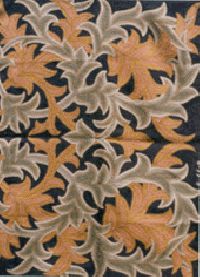
chain stitch rug
The designs range from floral patterns to animal and human forms traced by a designer, while the craftsman embroiders in two-ply or three ply woollensilken yarn. The rug looks like a carpet in which the pile is substituted by the texture. Chainstitch rugs is used both as floor covering and wall hanging.
Size : 2x3, 3x5, 6x4, 6x9 and 9x12 feet
...more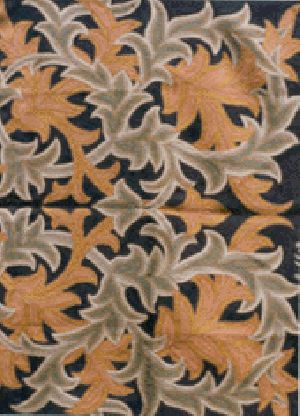
chain stitch
Chain Stitch - Natively known as "Jalakdozi", chain stitch rugs are the speciality of Kashmir. These rugs are made on "hessain cloth" or hand made cotton cloth, in continued stitch with superior woolen or silken yarn, with the help of a hook type tool natively called "Aurah". The designs range from floral patterns to animal and human forms traced by a designer, while the craftsman embroiders in two-ply or three ply woollen/silken yarn. The rug looks like a carpet in which the pile is substituted by the texture. Chainstitch rugs is used both as floor covering and wall hanging. The rug is supported with cloth-lining to add to the durability. It comes in sizes 2x3, 3x5, 6x4, 6x9 and 9x12 feet.
...more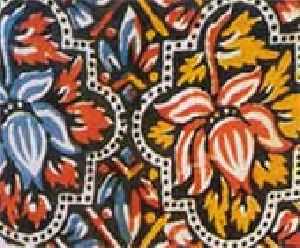
Calico Painting
Calico Painting - Samba, a small town about 40 kms from Jammu, on Jammu Pathankot highway is a well known centre of Block Printing. Calico Printing enjoys a wide popularity. Printing in vegetable color with help of wooden blocks on hand woven cotton cloth is being used as cool, comfortable, floor/bed coverings and are in great demand.
...more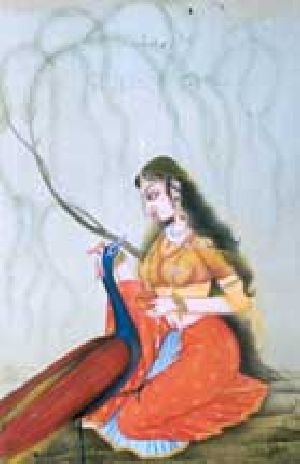
Basohli Painting
Basali is a town located in the foot-hills of Shivalik mountains in Kathua District of Jammu Division. In the late 17th century, Basali emerged as a great centre of painting. According to well known Dr. Herman Goltz, "Basali painting are among the great achievements of Indians". Their central inspiration is vashnavism, the themes have been taken from the epics and the puranas. The different themes of the paintings are religious (Gita Govinda and Ramayana), secular, historical, contemporary and literary. Besides the paintings bring out extreme emotion combined with a lyrical sense of Basali landscape. Basali paintings are said to have been described as Poems in colours. The paintings are marked by strikingly blazing colours bold lines, rich symbols and peculiar features giving an accumulative impact of highly sensuous environs.
...moreBe first to Rate
Rate ThisOpening Hours